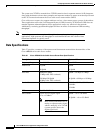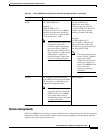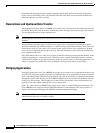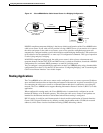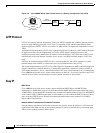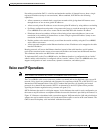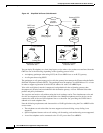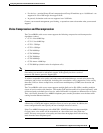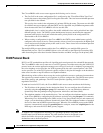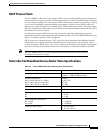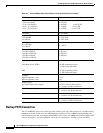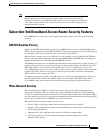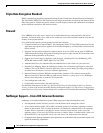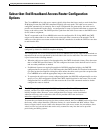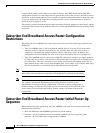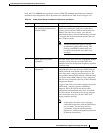
Configuring Subscriber-End Broadband Access Router Features
Voice over IP Operations
MC-620
Cisco IOS Multiservice Applications Configuration Guide
The Cisco uBR924 cable access router supports the following service classes:
• The first CoS in the router configuration file is configured as the “Tiered Best Effort Type Class”
used by the router as the primary QoS for all regular data traffic. The class has no minimum upstream
rate specified for the channel.
This service class results in the assignment of a primary SID for the router. The router uses this SID
for all MAC message exchanges with the CMTS, and as a data SID. Any SNMP management traffic
from the network to the Cisco uBR924 will also use this SID.
Although this class is strictly best effort, data traffic within this class can be prioritized into eight
different priority levels. The CMTS system administrator, however, must define the supported
upstream traffic priority levels and include the traffic priority fields in the configuration file
downloaded to the Cisco uBR924.
• When creating a configuration for the Cisco uBR924, the CMTS system administrator typically
configures extra classes of service. These secondary classes of service are expected to be higher QoS
classes and are used by higher priority traffic such as voice. These classes have a minimum upstream
rate specified for the channel.
The multiple SID-per-router feature enables the Cisco uBR924 to use multiple SID queues for
differentiated services. The Cisco uBR924 diverts voice call traffic to the higher QoS secondary SID,
while forwarding best-effort data from the Ethernet interface and MAC messages on the primary SID.
H.323 Protocol Stack
H.323 is an ITU standard that specifies call signalling and control protocols for a shared IP data network.
The Cisco uBR924 cable access router acts as an H.323 gateway. In architectures using the VoIP H.323
protocol stack, the session application manages two call legs for each call: a telephony leg managed by
the voice telephony service provider; the VoIP leg managed by the cable system operator—the VoIP
service provider. Use of the H.323 protocol typically requires a dial plan and mapper at the headend or
other server location to map IP addresses to telephone numbers.
When both legs of the call have been set up, the session application creates a conference between them.
The opposite leg transmit routine for voice packets is given to each provider. The CMTS router passes
data to the gateway and gatekeeper. The H.323 stack provides signalling via H.225 and feature
negotiation via H.245.
To make and receive H.323 calls, the Cisco uBR924 cable access router must know the following:
• The IP address of the gateway for the destination dialed. You can configure these IP addresses
statically using the voip dial peer group CLI commands, or you can obtain these addresses
dynamically from the gatekeeper using Registration, Admission, and Status (RAS).
• The telephone numbers of the attached devices. You can configure the telephone numbers attached
to the Cisco uBR924 by configuring the IP addresses statically using the pots port CLI commands.
When using Cisco Network Registrar (CNR) version 3.0 or later with the relay.tcl and setrouter.tcl
scripts, you can obtain these addresses dynamically from CNR. The telephone numbers of attached
devices are then sent in DHCP response messages. When the Cisco uBR924 processes the DHCP
response, it automatically creates the pots dial peer for each port, creates the voip dial peer for the
RAS target, and starts the H.323 RAS gateway support.
Note To support voice configurations involving Cisco gatekeeper products using RAS, the
headend must have IP multicast enabled. The cable interface must be designated as the
default for RAS to discover the gatekeeper. The gatekeeper then resolves all dialed
destinations sent to the RAS protocol.



